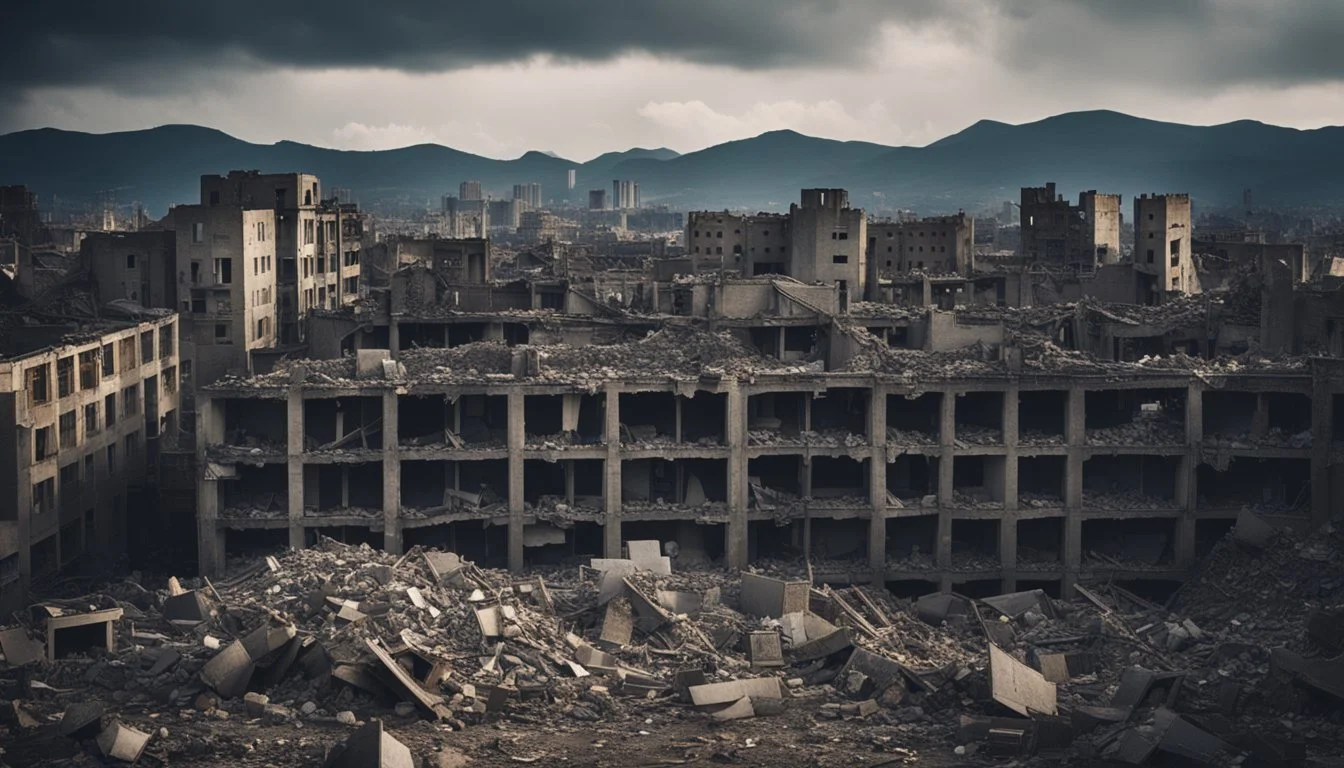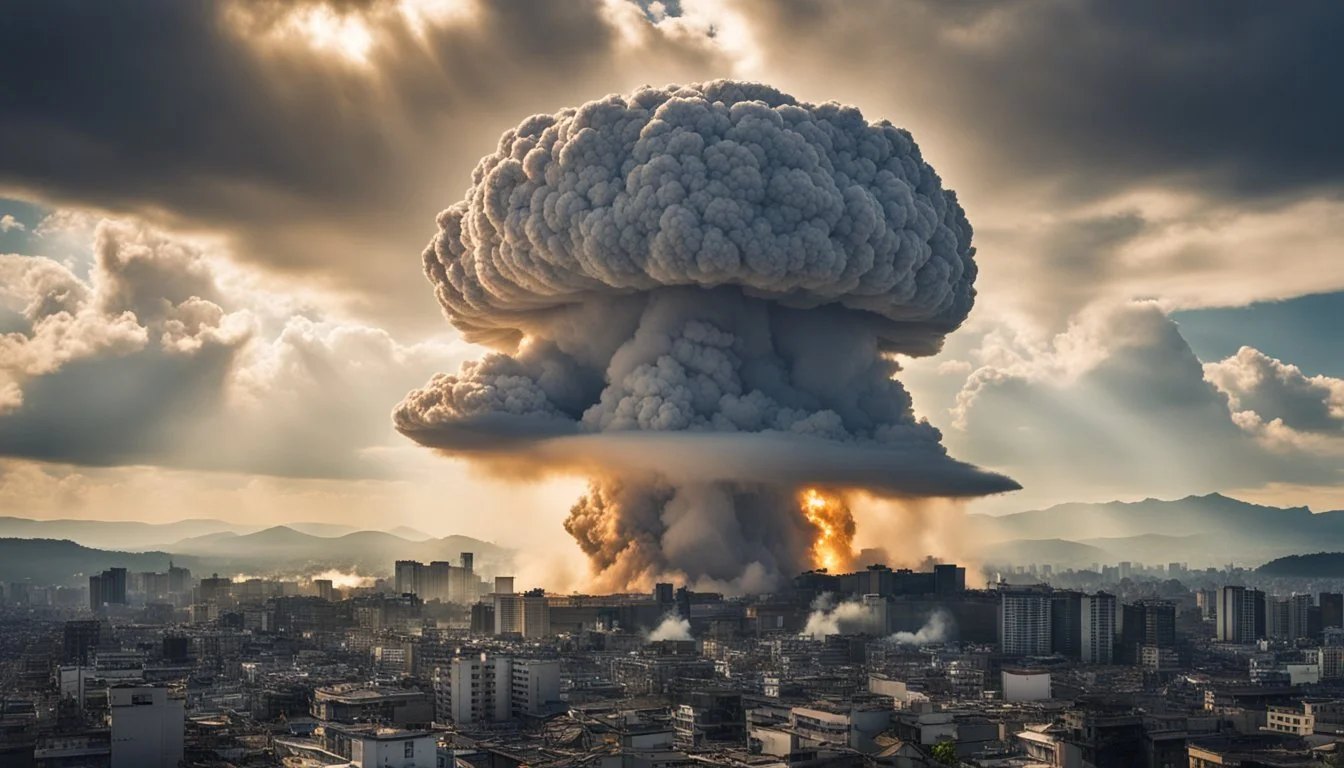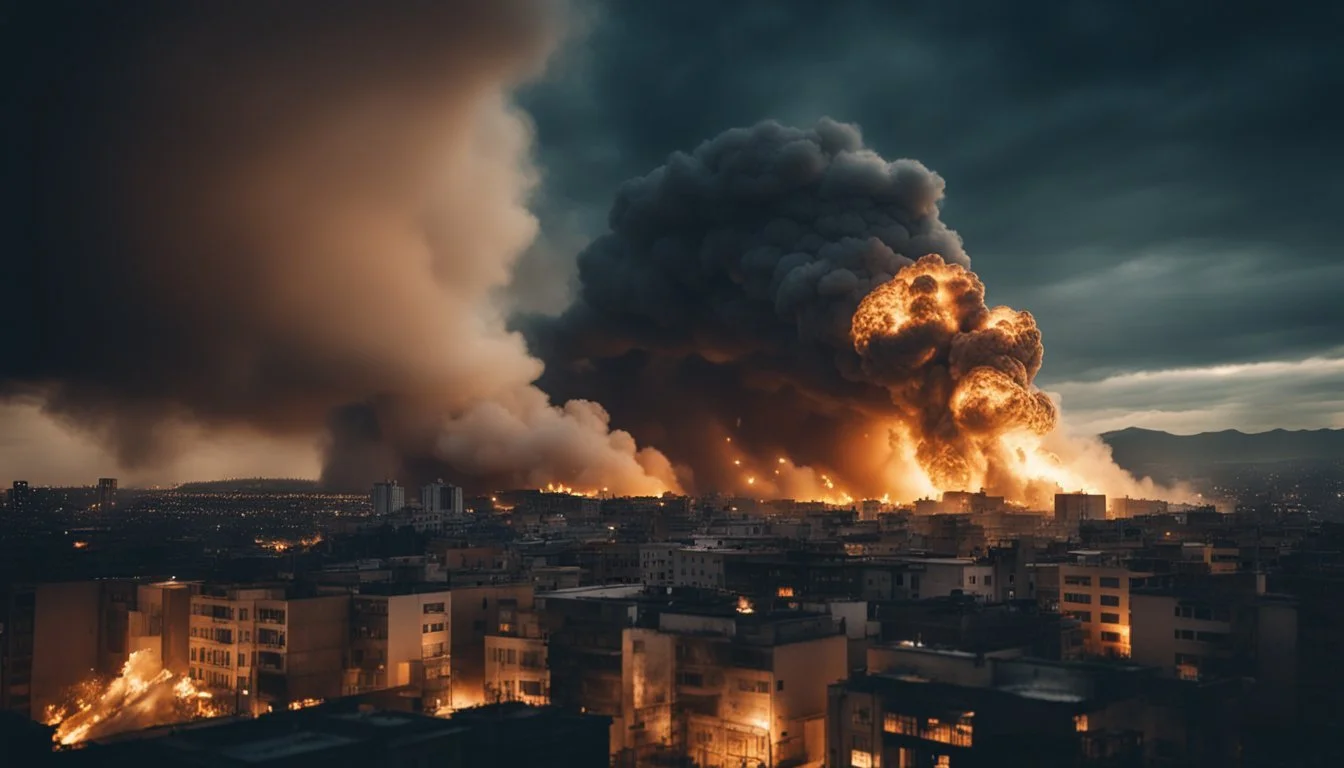9 Haunting Documentaries About the Atomic Bombings of Japan
Unveiling the Devastating Legacy of Hiroshima and Nagasaki
The atomic bombings of Hiroshima and Nagasaki in August 1945 marked a turning point in human history. These events left an indelible mark on the world and continue to shape discussions about warfare, nuclear weapons, and their consequences. Numerous documentaries have explored this pivotal moment, offering diverse perspectives on the bombings and their aftermath.
Documentaries about the atomic bombings provide viewers with valuable insights into the historical context, scientific developments, and human stories surrounding these events. They often feature interviews with survivors, archival footage, and expert analysis to create a comprehensive picture of the bombings and their long-lasting impact. These films serve as important educational tools, helping audiences understand the complexities of this chapter in world history.
1) White Light/Black Rain: The Destruction of Hiroshima and Nagasaki (2007)
White Light/Black Rain is a documentary directed by Steven Okazaki, released on HBO in 2007. The film marks the 62nd anniversary of the atomic bombings of Hiroshima and Nagasaki.
The documentary features interviews with fourteen Japanese survivors and four Americans involved in the 1945 bombings. It provides a stark look at the aftermath of the nuclear attacks.
Okazaki's film uses extensive archival footage to complement the survivor testimonies. This approach offers viewers a comprehensive understanding of the events and their long-lasting impact.
The documentary explores the physical and psychological effects of the bombings on the survivors. It also examines the broader implications of nuclear warfare.
White Light/Black Rain presents an unfiltered view of the first use of nuclear weapons in war. The film aims to educate viewers about this pivotal moment in history.
2) Hiroshima Nagasaki August, 1945 (1970)
This powerful documentary provides a stark look at the aftermath of the atomic bombings of Hiroshima and Nagasaki. Directed by Erik Barnouw, Paul Ronder, and Akira Iwasaki, the film uses footage shot by Japanese cameramen in the days following the attacks.
The filmmakers present a haunting visual record of the devastation and human suffering caused by the nuclear explosions. Scenes of destroyed buildings, burned victims, and shell-shocked survivors paint a grim picture of the bombs' effects.
Narration is kept to a minimum, allowing the raw imagery to speak for itself. The film's approach lets viewers confront the reality of nuclear warfare without filters or dramatization.
"Hiroshima Nagasaki August, 1945" stands as an important historical document and a sobering reminder of the human cost of atomic weapons. Its unflinching portrayal makes it a vital entry in atomic bomb documentaries.
3) The Day After Trinity (1981)
The Day After Trinity explores the life and work of J. Robert Oppenheimer, the physicist who led the Manhattan Project. This documentary provides an intimate look at the man behind the atomic bomb.
Director Jon Else combines archival footage and interviews with Oppenheimer's colleagues and family members. The film delves into the scientist's complex personality and the moral dilemmas he faced.
The documentary covers Oppenheimer's early career, his leadership of the Los Alamos laboratory, and the Trinity test. It also examines his later opposition to the hydrogen bomb and subsequent security hearing.
Viewers gain insight into Oppenheimer's famous quote from the Bhagavad Gita: "Now I am become Death, the destroyer of worlds." The film explores the psychological impact of creating such a devastating weapon.
The Day After Trinity offers a thoughtful examination of scientific responsibility and the ethical implications of nuclear weapons development. It remains a compelling portrait of a brilliant but troubled figure in modern history.
More information on The Day After Trinity, on IMDb.
4) Atomic Wounds (2006)
"Atomic Wounds" offers a poignant look at the long-term effects of nuclear warfare through the eyes of Dr. Shuntaro Hida, a survivor of the Hiroshima bombing. Directed by Marc Petitjean, this documentary follows the 89-year-old doctor as he continues to care for fellow survivors.
The film sheds light on the ongoing health issues faced by those exposed to radiation, known in Japan as "hibakusha". It explores how the dangers of radiation were initially downplayed by American authorities in the aftermath of the bombings.
Dr. Hida's dedication to treating atomic bomb survivors forms the emotional core of the documentary. His firsthand experiences and medical expertise provide valuable insights into the long-lasting impact of nuclear weapons on human health.
"Atomic Wounds" combines interviews, archival footage, and medical examinations to create a comprehensive picture of the bombing's aftermath. It serves as both a historical record and a cautionary tale about the devastating consequences of nuclear warfare.
5) Black Rain (1989)
"Black Rain" is a powerful documentary that explores the aftermath of the atomic bombing of Hiroshima. The film takes its name from the radioactive precipitation that fell after the explosion, causing severe health effects for survivors.
Directed by Shohei Imamura, this Japanese film blends historical footage with dramatized scenes to depict the experiences of hibakusha (atomic bomb survivors). It focuses on the story of Yasuko, a young woman exposed to the black rain.
The documentary highlights the long-term physical and psychological impacts of radiation exposure. It portrays the discrimination faced by survivors and their struggles with ongoing health issues.
"Black Rain" offers a somber reflection on the human cost of nuclear warfare. It serves as a poignant reminder of the devastating consequences that persist long after the initial destruction.
6) Hellfire: A Journey from Hiroshima (1986)
Hellfire: A Journey from Hiroshima documents the creation of the Hiroshima Murals by artists Iri and Toshi Maruki. The film showcases their decades-long collaboration to depict the devastating effects of the atomic bomb through art.
Directed by John Junkerman, this documentary received an Academy Award nomination. It captures the Marukis' artistic process and their commitment to preserving the memory of the Hiroshima bombing.
The Hiroshima Murals, featured prominently in the film, have been viewed by over 100 million people worldwide. These powerful artworks serve as a testament to the human cost of nuclear warfare.
Hellfire: A Journey from Hiroshima provides insight into the artists' motivations and the impact of their work. The documentary explores how art can be used to confront historical tragedies and promote peace.
Through interviews and footage of the Marukis at work, the film offers a unique perspective on the long-term cultural response to the atomic bombings of Japan.
For more information on Hellfire: A Journey from Hiroshima, visit IMDb.
7) Rhapsody in August (1991)
Akira Kurosawa's "Rhapsody in August" explores the lasting impact of the atomic bombing on three generations of a Japanese family. The film centers on an elderly hibakusha who lost her husband in Nagasaki.
Set in present-day Japan, the story unfolds as the grandmother cares for her four grandchildren during summer. Through their interactions, the film examines how different generations perceive and process the tragedy.
Kurosawa takes a subtle approach, focusing on personal experiences rather than graphic depictions of the bombing. The film touches on themes of memory, family bonds, and reconciliation.
"Rhapsody in August" features a mix of Japanese and American actors, including Richard Gere. This casting choice adds an international dimension to the narrative, reflecting on post-war relations between Japan and the United States.
While not a documentary, the film offers a poignant fictional perspective on the atomic bombing's long-term effects. It provides insight into how families and individuals continue to grapple with the event decades later.
8) Message from Hiroshima (2015)
"Message from Hiroshima" offers a poignant look at the devastating effects of the atomic bomb dropped on Hiroshima in 1945. Directed by Masaaki Tanabe, this documentary provides viewers with an intimate perspective on the city's history and the impact of nuclear warfare.
The film features testimonials from survivors, giving voice to those who experienced the bombing firsthand. These personal accounts offer a powerful and emotional narrative, bringing the historical events to life.
Computer-generated recreations of Hiroshima before the attack allow viewers to visualize the city and way of life that were lost. This innovative approach helps bridge the gap between past and present, making the tragedy more tangible for modern audiences.
Narrated by George Takei, "Message from Hiroshima" explores the culture and daily life in the city prior to the bombing. It focuses on the Nakajima district, now the site of the Peace Memorial Park, which was once home to thousands of people.
The documentary serves as both a historical record and a call for peace, emphasizing the long-lasting consequences of nuclear weapons and the importance of preventing such devastation in the future.
9) Paper City (2021)
Paper City focuses on the devastating firebombing of Tokyo in March 1945. This lesser-known attack claimed over 100,000 lives in a single night, surpassing the death tolls of Dresden and Hiroshima.
Director Adrian Francis explores the long-lasting impact of this event through the eyes of three survivors. Hiroshi Hoshino, Michiko Kiyooka, and Minoru Tsukiyama share their harrowing experiences from that fateful night.
The documentary sheds light on the often-overlooked bombing campaign against Japan's cities. It reveals the immense destruction and loss of civilian life that occurred before the atomic bombings of Hiroshima and Nagasaki.
Paper City examines themes of memory, loss, and the lasting trauma of wartime experiences. It offers a poignant look at how survivors have grappled with their memories decades after the event.
Through intimate interviews and archival footage, the film provides a powerful testament to the human cost of warfare. It serves as a reminder of the devastating consequences of aerial bombardment on civilian populations.
Historical Context of the Atomic Bombings
The atomic bombings of Japan in 1945 marked a pivotal moment in World War II and global history. These events were shaped by complex geopolitical factors and key decision-makers on both sides of the conflict.
Pre-World War II Japan
Japan's expansionist policies in the 1930s set the stage for its involvement in World War II. The country sought to establish dominance in East Asia and the Pacific, leading to conflicts with China and Western powers.
In 1937, Japan invaded China, triggering the Second Sino-Japanese War. This aggression alarmed the United States and other nations, resulting in economic sanctions against Japan.
The Japanese government, led by militarists, viewed these sanctions as a threat to their imperial ambitions. This tension ultimately contributed to Japan's decision to attack Pearl Harbor in 1941.
Key Figures Involved
President Harry S. Truman made the final decision to use atomic weapons on Japan. He assumed office after Franklin D. Roosevelt's death in April 1945, inheriting the Manhattan Project.
General Leslie Groves directed the Manhattan Project, overseeing the development of the atomic bomb. J. Robert Oppenheimer served as the scientific director, leading the team of physicists at Los Alamos.
On the Japanese side, Emperor Hirohito played a crucial role. While his exact involvement in military decisions remains debated, his support for surrender after the bombings was pivotal.
Prime Minister Kantarō Suzuki led Japan's wartime government. His cabinet was divided on the issue of surrender, even after the atomic bombings.
Impact on Hiroshima and Nagasaki
The atomic bombings of Hiroshima and Nagasaki had devastating immediate and long-lasting consequences. These events reshaped the physical landscape of both cities and profoundly affected the lives of survivors for generations to come.
Immediate Aftermath
The explosions instantly vaporized thousands of people near the hypocenter. Intense heat and radiation caused severe burns and injuries to survivors. Fires raged through the cities, destroying buildings and infrastructure.
Many victims died from acute radiation sickness in the days and weeks following the attacks. Hospitals were overwhelmed with injured and dying patients.
Rescue efforts were hampered by destroyed roads and widespread contamination. Food and water supplies were disrupted, leading to malnutrition and dehydration among survivors.
Long-Term Effects on Survivors
Radiation exposure led to increased cancer rates, particularly leukemia, among survivors. Birth defects and developmental issues affected children born to exposed parents.
Many survivors faced discrimination due to fears about radiation contamination. Psychological trauma and PTSD were common among those who witnessed the bombings.
Survivors, known as hibakusha, continue to advocate for nuclear disarmament. Their testimonies provide powerful firsthand accounts of the bombings' human toll.
Ongoing health studies of hibakusha and their descendants offer valuable data on long-term radiation effects. This research informs modern radiation protection standards and medical treatments.
Cultural Reflections in Documentary Filmmaking
Documentaries about the atomic bombings of Japan have evolved significantly over time, reflecting shifting cultural perspectives and filmmaking approaches. These films grapple with complex ethical considerations as they seek to portray historical events with sensitivity and accuracy.
Evolution of Narrative Styles
Early documentaries on Hiroshima and Nagasaki often relied heavily on archival footage and government propaganda materials. "The Atomic Cafe" (1982) exemplifies this approach, using period newsreels to explore the bombings' impact. More recent films like "White Light/Black Rain" (2007) incorporate survivor interviews, providing personal narratives alongside historical context.
Modern documentaries frequently employ creative storytelling techniques. Some use reenactments or animation to visualize survivors' memories. Others, like "Atomic Cover-Up," focus on previously classified footage to offer new perspectives on familiar events.
Ethics and Responsibilities of Filmmakers
Documentarians face ethical challenges when addressing sensitive topics like atomic warfare. Filmmakers must balance the need to inform audiences with respect for survivors' trauma. Many recent productions prioritize survivor voices, allowing them to share their experiences directly.
Accuracy and objectivity are paramount. Responsible filmmakers consult historians and fact-check rigorously to avoid perpetuating myths or misinformation. Some documentaries, such as those produced by the BBC, explore innovative ways to preserve survivor stories for future generations.
Ethical considerations extend to visual representations as well. Filmmakers must decide how graphically to depict the bombings' aftermath, weighing educational value against potential distress to viewers.




